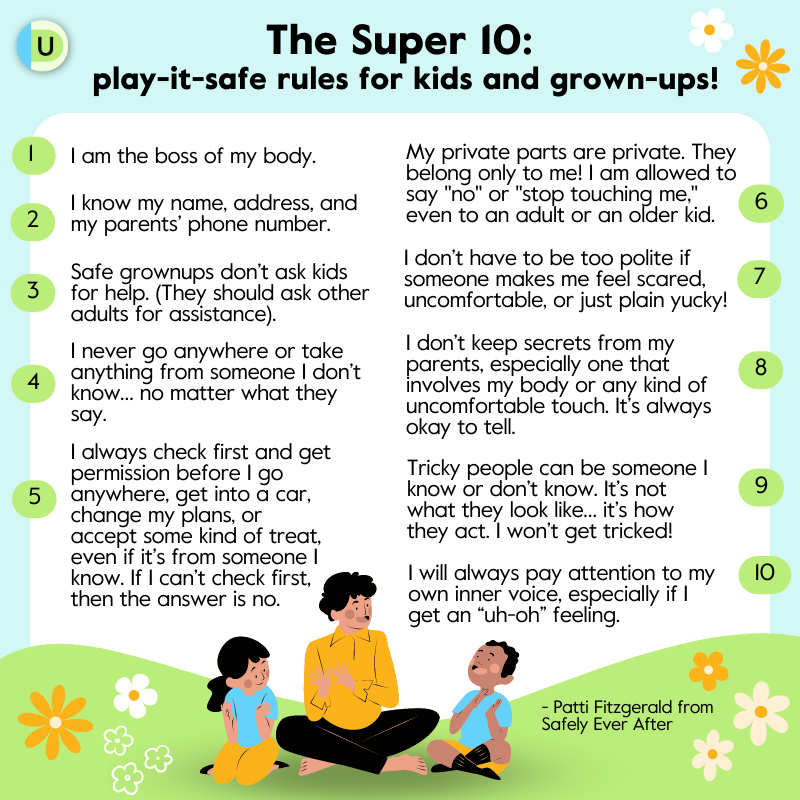Talking to Kids About Personal Safety
As parents, our first concern is to keep our children safe. Most of us had “stranger danger” drilled into us as children, a fear encompassing abductions by strangers as well as the many instances of sexual, emotional, and physical abuse that children may be exposed to. So how do we explain this concept to our kids with disabilities without making them unnecessarily fearful? How do we teach them the skills and strategies they need to protect themselves?
It’s reassuring to know that the stereotypical idea of “stranger danger” — say, a stranger in a passing windowless van grabbing a child off the street — is actually extremely rare. Although the National Center for Missing and Exploited Children assisted with 29,782 cases of missing children in 2020, only 27 of those cases involved abduction by a non-family member. The U.S. Department of Justice’s Office of Juvenile Justice and Delinquency Prevention 2011 report also found that abduction by a stranger is exceedingly rare — a risk of less than two in a million — and that the numbers of abducted children are consistently falling.
It's important to recognize that most cases of child abduction, exploitation, and abuse happen with people we know — family members, caregivers, school employees, friends’ parents, and other children — NOT with strangers. So what can we do about it?
Terminology and statistics
Instead of “strangers,” we should warn our kids about “tricky people,” who might be someone they know. Another reason not to warn children only of “strangers” is that they shouldn’t assume they should trust someone just because they’ve known them for a while. According to the FBI, children are increasingly introduced to “tricky people” through the internet and video games, where they can be “cyber-groomed” for long periods of time before they’re asked to meet in person.
For children with disabilities, the risk of abuse is greater in part because they are exposed to many more adult therapists and caregivers, and they need intimate care for longer periods of time. They may also be ill-equipped to understand often fairly nuanced differences between care and abusive touch. Children whose communication skills are still emerging are particularly vulnerable to being unable to report abuse.
The statistics are incredibly hard to read, but you should know that an estimated 39–68% of girls and 16–30% of boys with developmental disabilities will be sexually abused before age 18. However, research shows that knowledge of sexuality, abuse, and self-protection reduces the risk of sexual abuse — so the good news is there is much we can do to teach our children with disabilities to protect themselves, including assertiveness and social skills training.
Many parents find it frustrating that strategies tend to focus on how to help children report abuse rather than preventing it. But children need to be effective reporters, and they need to understand both medical and slang terminology that abusers use in order to recognize the types of situations they may find themselves in. Most importantly, we as parents need to work to be the open, trusted adults that our kids can talk to about difficult things without fear of judgment (not easy!).
Strategies, communication tools, words, and signs are key to empowering our children to say no.
How do we talk about risks?
Typically developing children are often taught these tools in sex education programs such as those mandated by California law. But many schools do not provide accessible modifications for special education classrooms or for visual learners and non-readers.
Patti Fitzgerald from Safely Ever After has some great tips to help parents talk about “stranger danger" with their children. For example, she advises they learn that: “Tricky people can be someone I know or don’t know. It’s not what they look like … it’s how they ACT, what they say or want me to do. I won’t get tricked!” Patti offers these ten rules for kids to keep them safe.
The SEEDS Therapy Center in San Diego has developed a curriculum focused on helping kids and young adults with disabilities understand puberty and preparing them for healthy, safe relationships. You can learn some of the strategies they use — and read some of clinical director Amy Machado’s wonderful advice — in our article on preparing kids for puberty.
Teaching relationships and consent to kids
Who is a stranger? Who is a friend? Circles of Intimacy is a popular curriculum used to teach students with intellectual and developmental disabilities about the many individuals they encounter every day and the levels of intimacy that are permitted and expected. These videos make great teaching tools and can often be found at your local resource center or school. There are also many similar lesson plans inspired by this approach available online. The circles help students identify the closest people to them and — importantly — the paid helpers they may spend most of their day with.
As we discuss in our article about puberty, consent can be problematic for kids who may have experienced many situations in which their body autonomy is not respected by loving parents who seem to constantly wipe their noses and mouths, feed them medicine, clip their toenails, brush their teeth, and (the worst!) cut their hair. They may also have to endure frequent blood draws, shots, and other uncomfortable exams and procedures. How can we teach children that their body is their own if we do not ask permission and respect their right to refuse? Terri Couwenhaven, MS and AASECT Certified Sex Educator, recommends using an intimate care model that always asks permission, even to wipe their face, and allows individuals to refuse for now but keep trying.
Allow a lot of time for talking to your child to elicit their consent. They may need to understand why they need to do it, along with a really great reward to look forward to, and a lot of praise for being brave.
See our full article for more information and tips on [teaching consent to children with disabilities](/resources/3003.
Specialized teaching and resources
While many children have great sex education classes in school, it is important for children with disabilities to have access to specialized classes that are designed with them in mind. Many Regional Centers offer a class for children ages nine and up on bodies and boundaries. You might also find a class by the amazing Terri Cowenhaven.
You can also talk to your school about using curriculum materials that include modifications for students with disabilities, such as Positive Prevention Plus.
If you can’t find a class, there are a number of books that can guide your conversation with your child. It’s especially helpful to have pictures for visual learners to assist them in identifying body parts that are private. Here are a few examples:
Cyber safety for kids
If your children are able to access the internet independently, you should set clear family agreements on cyber interactions. Most importantly, ensure that your children know never to disclose their address, school name, or other information that can be used to locate them. Children should also never have access to online payments.
There are a number of resources available to assist with talking about cyber safety, including:
- Online Teen Safety Guide
- Keeping Children Safe Online
- Stop, Think, Connect — Chatting with Kids About Being Online
The FBI's Safe Online Surfing (SOS) program, which teaches students in third to eighth grade how to navigate the web safely, covering topics like cyberbullying, protecting personal information, recognizing trustworthy and untrustworthy sites, and avoiding malware.
What are some of the strategies you’ve used to talk to your kids about these important concepts? Let us know!
Join for free
Save your favorite resources and access a custom Roadmap.
Get StartedAuthor






